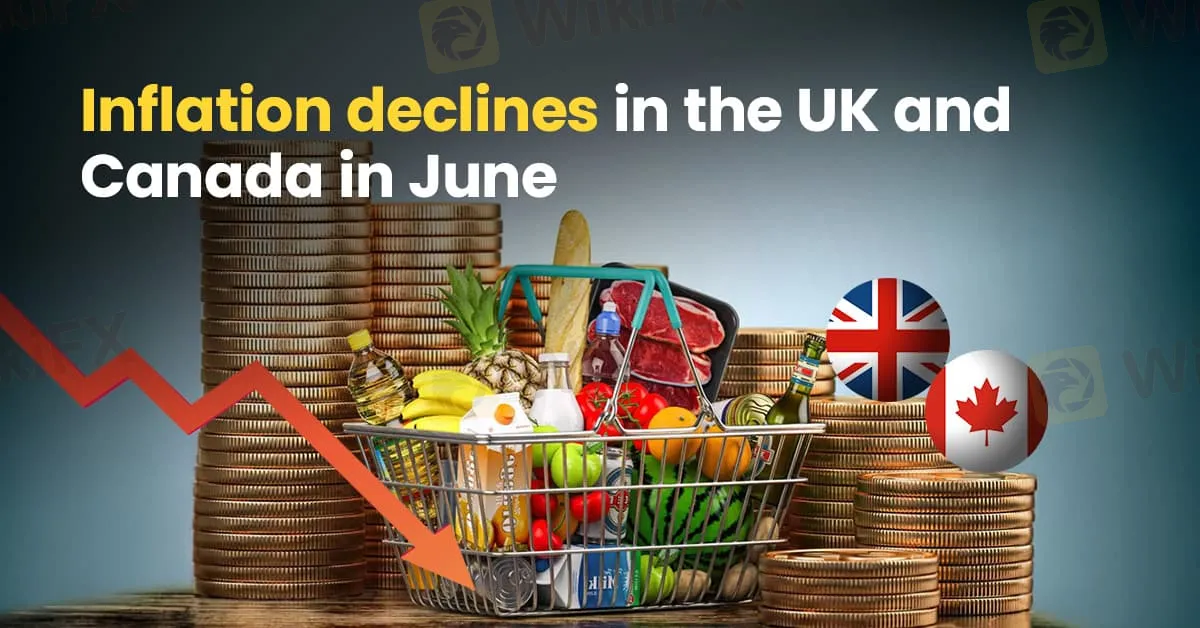简体中文
繁體中文
English
Pусский
日本語
ภาษาไทย
Tiếng Việt
Bahasa Indonesia
Español
हिन्दी
Filippiiniläinen
Français
Deutsch
Português
Türkçe
한국어
العربية
Inflation declines in the UK and Canada in June
Abstract:In June, both Canada and the UK experienced a notable decline in inflation rates. This trend aligns with the broader global movement toward lower inflation. The British Pound (GBP) rose sharply against the US Dollar (USD), while Canadian benchmark stock indices showed significant gains.

In June, both Canada and the UK experienced a notable decline in inflation rates. This trend aligns with the broader global movement toward lower inflation. The British Pound (GBP) rose sharply against the US Dollar (USD), while Canadian benchmark stock indices showed significant gains.
Inflation Falls in The UK
In the UK, a positive inflation report pushed the British Pound higher. The CPI remained at 2% year-on-year, unchanged from June, which aligns with the Bank of Englands (BoE) inflation target. Core CPI also remained steady at 3.5% year-on-year. Every month for June, CPI dropped from 0.3% to 0.1%, while core CPI eased from 0.5% to 0.2%.
However, UK services inflation remained unchanged in June at 5.7% year-on-year, nearly three times the BoE‘s inflation target. This persistent high services inflation could complicate the BoE’s plans to lower interest rates.
Inflation Falls in Canada
Canadas Consumer Price Index (CPI) rose by 2.7% year-on-year in June, down from 2.9% in May, matching a three-year low from April. Monthly, CPI posted a 0.1% decline, a sharp drop from the 0.6% increase in May. This was the first monthly decline of the year, primarily driven by a significant reduction in gasoline prices.
However, Core CPI, which excludes food and energy prices, rose by 1.9% year-on-year, slightly up from 1.8% in May. Despite this increase, it remained below the Bank of Canadas (BoC) inflation target of 2%.
Conclusion
These inflation reports indicate a continuing disinflationary trend, which supports the case for interest rate cuts. The Bank of Canada has already lowered rates in June, and it is likely only a matter of time before the Bank of England follows suit.
The USD/CAD currency pair showed little movement in response to the inflation release, while the GBP/USD pair experienced strong gains of 0.52% and 0.67% respectively following the inflation reports.
On the stock market, Canadian benchmark stock indices climbed sharply while UK indices showed a slight decline. The S&P/TSX (Canada) surged 1.07% on Tuesday, rising 243 points to close at 22,995. In contrast, the FTSE 100 (UK) fell by 28 points (0.36%) to 8,136 on Wednesday.
These developments reflect the mixed reactions in financial markets to the evolving inflation landscape in both countries.

Disclaimer:
The views in this article only represent the author's personal views, and do not constitute investment advice on this platform. This platform does not guarantee the accuracy, completeness and timeliness of the information in the article, and will not be liable for any loss caused by the use of or reliance on the information in the article.
Read more

Crypto, Euro, Yuan: Still No Dollar Killer
Despite frequent “de-dollarization” headlines, the U.S. dollar remains unrivaled due to unmatched market depth, global usability, and trusted legal/institutional frameworks. Crypto and other currencies (euro, yuan) lack the stability, convertibility, and infrastructure required to replace the USD, while the Fed’s credibility and the scale of U.S. financial markets continue to anchor demand. Bottom line: no alternative currently offers a complete, credible substitute for the dollar’s global role.

100% Tariff Incoming: Trump Announces November Hike on China
The U.S. will impose an additional 100% tariff on Chinese imports starting Nov. 1, 2025—potentially earlier—alongside new export controls on “critical software,” escalating tensions after Beijing’s rare-earth curbs, new port fees, a Qualcomm probe, and a halt to U.S. soybean purchases. Stocks fell on the news. Key context: some U.S.-China tariffs remain paused until Nov. 10, a Supreme Court case could reshape Trump’s tariff authority, new U.S. duties on cabinets (Oct. 1) and wood products (Oct. 14) are in force, and a pause on Mexico tariffs is set to end next month.

What is NFP in Forex? An Insightful Guide for Traders
The Non-farm Payroll (NFP) report may be for the US. However, the report, which is issued every month, impacts the forex market globally. The monthly report estimates the number of jobs gained in the US in the previous month. The job numbers stated on this report exclude those of farms, private households, and non-profit organizations. Usually released on the first Friday of the month, the report also includes the US unemployment rate, average hourly earnings, and participation rate. In this article, we have answered the question - what is NFP in forex - and shared other pertinent details. Read on!

Fed Rate Cuts May Not Happen in July, Markets Await Policy Meeting Minutes Release
Federal Reserve officials had a meeting on June 17-18 during which some of them expressed a fall in interest rates in July. However, a lot of policymakers are still worried about the inflationary pressures that might emerge from US President Donald Trump’s import tariff decisions aimed at changing global trade. So, it seems the rate cut may not happen in July. Read this to know more.
WikiFX Broker
Latest News
US and UK Sanction Cambodia-Based Prince Group Over $16B Scam
UAE Launches Sixth 'Caution' Campaign to Combat Forex and Online Investment Fraud
David Stockman On How The Fed's Money Printing Broke American Industry... And What Comes Next
Forex24 Faces CySEC Fine for Late Compliance Filing
One Wrong Move Wiped Out a Government Retiree’s Lifetime Savings
MH Markets Review 2025: Trading Platforms, Pros and Cons
Octa FX in Pakistan: The Complete Guide to Local Payments, Regulation, and Support
Mekness Review: Traders Report Alleged Fund Scams & Account Blocks
INTERPOL, AFRIPOL Crack Down on Africa Terror Finance
Forex Scam Checker Philippines: Verify Brokers with WikiFX
Currency Calculator



